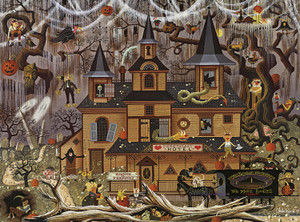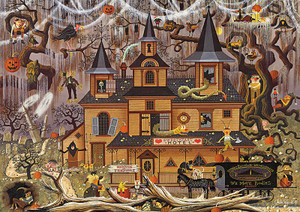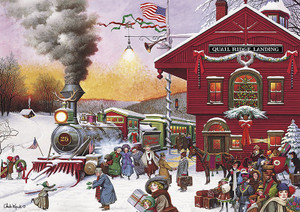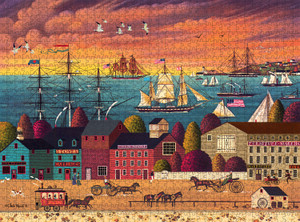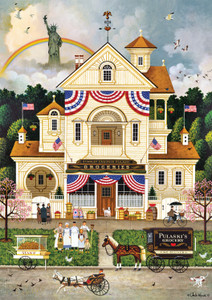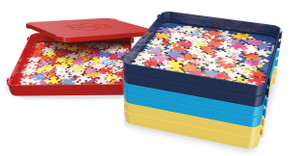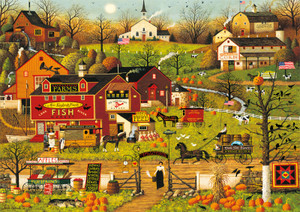Posted by Buffalo Games on Apr 22nd 2022
The Fastest Way to Solve a 1,000-Piece Puzzle
A 1,000-piece puzzle can pose an exciting challenge for anyone who enjoys the process of assembling a complete image from a jumble of parts. With that being said, busy adults might not have a ton of time to devote to this fun and rewarding activity.
The good news is that you don’t have to waste undue time staring at a pile of pieces in search of the one you want. With proper preparation and organization, you can shorten the time it takes to complete a complex puzzle so it fits in with the many demands of your daily life. Here are a few key tips and tricks to get you started.
Don’t Skimp on Prep
A good process of preparation can be a real lifesaver when you’re taking on 1,000 or 2,000-piece puzzles — or even more impressive projects. Starting with the proper workspace can make a huge difference, as can getting together the tools you’ll need for convenient sorting. How should you get started when tackling a detailed Charles Wysocki or Aimee Stewart puzzle? Take a look at the next few tips!
Select a Suitable Surface
First and foremost, you need the right kind of surface to manage a puzzle of this size. If you’re doing 100- or 300-piece puzzles, for example, it might not matter too much if your table surface is a bit rough, as you won’t be at it for long.
For larger puzzles that are likely to take several hours and require a lot of sorting and moving of pieces, a flat, smooth surface is vital.
A white or black surface is ideal because it will provide contrast against puzzles that are largely dark or light in color, helping you to more easily identify pieces. If you don’t have a card table or other surface that meets these criteria, a portable puzzle mat is a great option.
These mats come in a variety of colors, they roll up for easy storage when not in use, and if you have to walk away from your puzzle to eat, sleep, or pick up the kids from soccer practice, you can simply roll it to keep your puzzle pieces in place until you come back (no more worrying about pets and toddlers!).
Measure Your Workspace
100-piece puzzles are likely to fit just about anywhere, from a card table to a coffee table, or even a TV tray, as long as the pieces aren’t outlandishly large. The same may not be true when you’re dealing with 1,000 pieces or more.
The best thing you can do, then, is to measure before you start to make sure you have plenty of room to work. Note the puzzle dimensions listed on the box and make sure your table has a couple of inches of clearance beyond that at the very least.
Ideally, you’ll want a minimum of a few inches on two or more sides for sorting pieces and building small sections before adding them to the larger image.
Separate Like a Pro
Sorting is an important part of shaving time off your overall build. While you can certainly create piles all around your puzzle edges, when you do that, you risk pieces getting mixed after separation if your table is bumped or you’re just sifting through piles in search of something particular.
When it comes to assembling complex jigsaw puzzles for adults, setting up a system of separation can make your life a lot easier. Consider using plastic food storage containers for the task. You can find shallow containers inexpensively at the grocery store. They’ll keep sorted groups together, they have lids to prevent interference by kids or pets, and they stack for easy storage when not in use.
Sort and Sort Again
With a smaller piece count, up to about a 500-piece jigsaw puzzle, sorting could include little more than separating edge pieces from the pack. However, with more pieces comes a greater need for categorization.
One useful method involves separating by color groups and perhaps further sorting by pattern or texture if there are a lot of areas with similar colors throughout.
You can also look for identifiable details like faces, architectural features, animals or plants, and so on. Finally, you can get really granular by separating out pieces by the number of tabs and blanks and the configuration of images.
Schedule in Regular Breaks
Even with 500-piece puzzles, you may find you need a break at some point to hit up the restroom, have a meal, or go to bed, depending on when you start. When you go for 1,000 pieces or more, you’ll definitely need at least a couple of breaks.
It’s easy to get so involved with puzzling that you lose all track of time, but obsessing to the point where you forget to take care of necessities will only lead to fatigue, frustration, and ultimately, a longer timeline for completion.
Do It with a Group
Even friends who enjoy puzzling may balk at 2,000 or more pieces. They might not find 500 pieces to be a significant challenge. 1,000-piece options from your favorite puzzles store can be just the right fit for a group activity.
Best of all, you won’t have to spend hours paging through a rulebook to get started. You can simply dump the box to kick off the fun with family and friends of all ages (just check the boxes for recommended age levels first!).
Be Patient
When you just can’t find that one missing piece in the border or you feel like you’ve been looking for someone’s eyeball, an architectural anomaly, or another obvious visual reference forever, it can be tempting to flip your table and call it a day. The thing about choosing jigsaw puzzles with 1,000 or more pieces is that you know they’re going to be a challenge. That’s what makes solving them so rewarding.
The more you puzzle, the better you’ll get. You’ll hone your strategies, develop your ability to locate visual markers, and even improve hand-eye coordination, all of which will help you to move through the activity at a faster pace. Just get yourself into a Zen mindset, rather than stressing over finding a single piece, and you’ll not only get greater enjoyment from 1,000-piece puzzles, but you’ll find you actually complete them more rapidly.




